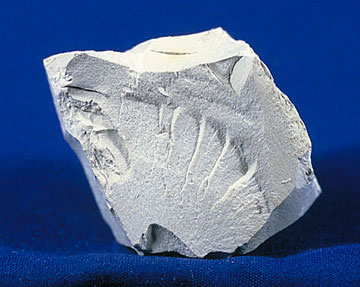Lustre (mineralogy)
Lustre (or luster) is a description of the way light interacts with the surface of a crystal, rock, or mineral. For example, a diamond is said to have an adamantine lustre and pyrite is said to have a metallic lustre. The term is also used to describe other items with a particular sheen (for example, fabric, especially silk and satin, or metals).
The word lustre traces its origins back to the Latin word lux, meaning "light", and generally implies radiance, gloss, or brilliance.
Terminology
A broad range of terms are used to describe the lustre of minerals. It should be noted that lustre varies over a wide continuum, and so there are no rigid boundaries between the different terms. (For this reason, different sources can often describe the same mineral differently.) The terms are frequently combined to describe intermediate types of lustre (for example, a "vitreous greasy" lustre).
Adamantine lustre
Adamantine minerals possess a superlative lustre, which is most notably seen in diamond.[1] Such minerals are transparent or translucent, and have a high refractive index (of 1.9 or more).[2] Minerals with a true adamantine lustre are uncommon, with other examples being cerussite and zircon.[2]
Minerals with a lesser (but still relatively high) degree of lustre are referred to as subadamantine, with examples including sapphire and garnet.
Dull lustre

Dull (or earthy) minerals exhibit little to no lustre, due to coarse granulations which scatter light in all directions, approximating a Lambertian reflector. An example is kaolinite.[3] A distinction is sometimes drawn between dull minerals and earthy minerals,[4] with the latter being coarser, and having even less lustre.
Greasy lustre
Greasy minerals resemble fat or grease. A greasy lustre is often caused by a great abundance of microscopic inclusions within the mineral.[2] Examples include opal and cordierite. Many minerals with a greasy lustre also feel greasy.[5]
Metallic lustre
Metallic (or splendent) minerals have the lustre of polished metal, and in the ideal case will act as a mirror. Examples include galena, pyrite and magnetite.
Pearly lustre
Pearly minerals consist of thin transparent co-planar sheets. Light reflecting from these layers give them a lustre reminiscent of pearls.[6] Such minerals possess perfect cleavage,[2] with examples including muscovite and stilbite.
Resinous lustre
Resinous minerals have the appearance of resin, chewing gum or (smooth surfaced) plastic. A principal example is amber, which is a form of fossilled resin.
Silky lustre
Silky minerals have a parellel arrangement of extremely fine fibres,[2] giving them a lustre reminiscent of silk. Examples include asbestos, ulexite and the satin spar variety of gypsum. A fibrous lustre is similar, but has a coarser texture.
Submetallic lustre
Submetallic minerals have similar lustre to metal, but are duller and less reflective. A submetallic lustre often occurs in near-opaque minerals with very high refractive indices,[2] such as sphalerite, cinnabar and cuprite.
Vitreous lustre
Vitreous minerals have the lustre of glass. This type of lustre is one of the most commonly seen,[6] and occurs in transparent or translucent minerals with relatively low refractive indices.[2] Common examples include calcite, quartz and fluorite.
Waxy lustre
Waxy minerals have a lustre resembling wax. Examples include jade and chalcedony.
Optical phenomena
Asterism
Asterism is the display of a star-shaped luminous area. It is seen in some sapphires and rubies, where it is caused by impurities of rutile.[7][8] It can also occur in garnet, diopside and spinel.
Chatoyancy
Chatoyant minerals display luminous bands, which appear to move as the specimen is rotated. Such minerals are composed of parallel fibers (or contain fibrous voids or inclusions), which reflect light into a direction perpendicular to their orientation, thus forming narrow bands of light. The most famous examples are tiger's eye and cymophane, but the effect may also occur in other minerals such as aquamarine, moonstone and tourmaline.
Schiller
Schiller is a term used to describe the colourful iridescence that occurs when light is reflected between layers. It is seen in moonstone and labradorite.
See also
References
- ↑ Gemological Institute of America, GIA Gem Reference Guide 1995, ISBN 0-87311-019-6
- ↑ 2.0 2.1 2.2 2.3 2.4 2.5 2.6 Rudolf Duda, Lubos Rejl (1990). Minerals of the World. Arch Cape Press. ISBN 0-517-68030-0.
- ↑ "Optical properties of Rocks and Minerals". Retrieved 2008-06-01.
- ↑ Rosie Hankin (1998). Rocks, Crystals & Minerals. Quintet Publishing. ISBN 1-86155-480-X.
- ↑ "GO 340 Gemstones & Gemology". Retrieved 2008-06-19.
- ↑ 6.0 6.1 "Optical properties of Rocks and Minerals". Retrieved 2008-06-01.
- ↑ Emsley, John (2001). Nature's Building Blocks: An A-Z Guide to the Elements. Oxford University Press. pp. pp. , 451 &ndash, 53. ISBN 0-19-850341-5.
- ↑ Bonewitz, Ronald Louis (2005). Rock and Gem. Dorling Kindersley. pp. pp. , 152 &ndash, 153. ISBN 0-7513-4400-1.
cs:Lesk de:Glanz et:Läige it:Lucentezza dei minerali lv:Spīdums (mineraloģija) nl:Glans fi:Kiilto (mineralogia)